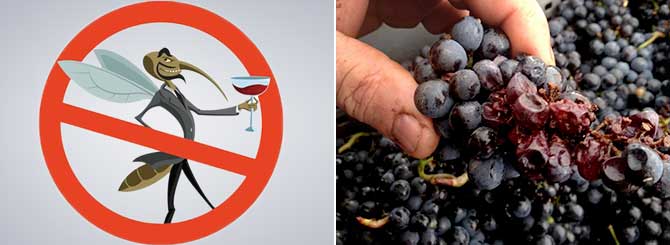Date£º
2014-09-26 11:32 Source£º
winesearcher Author:
Suzanne Mustacich Translator:
An Asian fruit fly, capable of infecting grapes with sour rot, is causing concern in Bordeaux.

Bordeaux's winegrowers face a growing menace in the form of a three-millimetre (0.1 inch) long Asian fruit fly called Drosophila suzukii, suspected of spreading sour rot through ripening grapes in otherwise healthy vineyards.
2014 is the first year both sour rot and specifically Drosophila suzukii, commonly known as the spotted wing drosophila, have been detected in Bordeaux's red wine vineyards.
"On September 10th, we saw the first symptoms in the Entre-Deux-Mers and certain sectors of Saint Eilion on sandy soil,?said Sophie Aribaud, technical consultant at the Union Regionale Agricole in Grezillac.
While the spotted wing drosophila itself undergoes close scrutiny, the damage remains limited to isolated plots.
"We see a few berries or a cluster infected, maybe a half to one percent of the vineyards,"said enologist Jean-Philippe Fort, part of Michel Rolland's team. "We prune out the infected grapes and clusters, then do the harvest. The infected fruit is destroyed."
Sour rot is easy to identify. It smells of vinegar. And it is not entirely unknown in Bordeaux.
Rain falls on an early ripening harvest, the berries burst and the common European vinegar fly, Drosophila melanogaster, arrives, feasting on the juice and laying eggs.
"Sour rot is a very old problem for white wines. I've always known it in Sauternes," said Denis Dubourdieu, the eminent researcher, consultant and chateau owner.
"The phenomenon halts relatively quickly with the return of dry, sunny weather at the start of harvest," said Dubourdieu. Nor does the episode preclude a top quality vintage - think Sauternes in 1997 and 2007.
But the anatomy of the Drosophila suzukii is a game changer.
The common vinegar fly has a blunt ovipositor - the tubular organ the female uses to deposit eggs. It cannot pierce the grape skin, so it only appears on damaged fruit.
The spotted wing drosophila, however, has an ovipositor with a hard, serrated edge, which can easily puncture the thick skin of a healthy grape even before it's fully ripe. It lays its eggs in the previously undamaged berry still attached to the vine, and the larvae quickly begin feeding on the soft fruit. At the same time, it spreads the bacteria and yeasts that produce sour rot.
Worse, the pests have an alarmingly rapid reproductive cycle.
"It's extremely virulent and dangerous," said Jean-Philippe Fort. "After 25 years in the field, this is the first time I've seen the symptoms for what could become a catastrophe. Right now it's not a problem on a big scale, but it risks becoming a very big problem."
It has already attacked vineyards in Canada, the West Coast of the U.S., Spain and Switzerland. Winegrowers in Alsace, the Cotes du Rhone and Burgundy have all reported damage.
On Burgundy's Pinot Noir grapes, "I have seen enormous losses in some plots," said Denis Dubourdieu.
Is Bordeaux next?
No one quite knows why the spotted wing drosophila and sour rot have arrived in France. Possibly weather has played a role. Insects easily survived last year's mild winter, and changes in global weather patterns might favor sour rot over gray rot, which does better in cooler temperatures.
The best solution is prevention, advised Dubourdieu. Growers must avoid overly large berries and sandy soil. Instead, plant on clay, gravel and limestone soils, limit the vigor of the vine, keep clusters well-aerated, plots drained and then encourage roots to grow deeply. But that won't help this year's vintage.
"Right now, today, we don't have a way to eradicate it," said Fort. "There are treatments that act as repellents. But from what I've observed in the field, when a repellent is used, [the insects] just move next door."